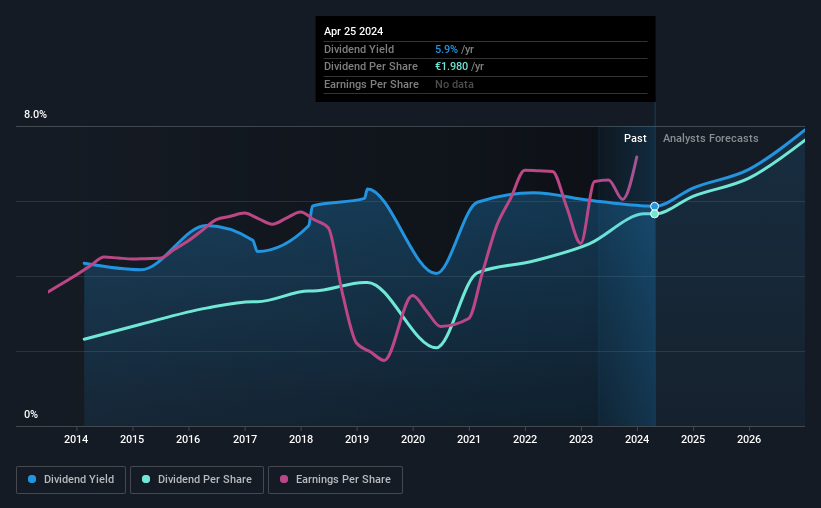Is It Smart To Buy AXA SA (EPA:CS) Before It Goes Ex-Dividend?

Regular readers will know that we love our dividends at Simply Wall St, which is why it's exciting to see AXA SA (EPA:CS) is about to trade ex-dividend in the next three days. Typically, the ex-dividend date is one business day before the record date which is the date on which a company determines the shareholders eligible to receive a dividend. The ex-dividend date is of consequence because whenever a stock is bought or sold, the trade takes at least two business day to settle. Meaning, you will need to purchase AXA's shares before the 30th of April to receive the dividend, which will be paid on the 6th of May.
The company's next dividend payment will be €1.98 per share, and in the last 12 months, the company paid a total of €1.98 per share. Calculating the last year's worth of payments shows that AXA has a trailing yield of 5.9% on the current share price of €33.80. We love seeing companies pay a dividend, but it's also important to be sure that laying the golden eggs isn't going to kill our golden goose! As a result, readers should always check whether AXA has been able to grow its dividends, or if the dividend might be cut.
Check out our latest analysis for AXA
Dividends are usually paid out of company profits, so if a company pays out more than it earned then its dividend is usually at greater risk of being cut. AXA is paying out an acceptable 63% of its profit, a common payout level among most companies.
Generally speaking, the lower a company's payout ratios, the more resilient its dividend usually is.
Click here to see the company's payout ratio, plus analyst estimates of its future dividends.

Have Earnings And Dividends Been Growing?
Stocks in companies that generate sustainable earnings growth often make the best dividend prospects, as it is easier to lift the dividend when earnings are rising. If business enters a downturn and the dividend is cut, the company could see its value fall precipitously. That's why it's comforting to see AXA's earnings have been skyrocketing, up 27% per annum for the past five years.
The main way most investors will assess a company's dividend prospects is by checking the historical rate of dividend growth. Since the start of our data, 10 years ago, AXA has lifted its dividend by approximately 9.3% a year on average. It's encouraging to see the company lifting dividends while earnings are growing, suggesting at least some corporate interest in rewarding shareholders.
To Sum It Up
Should investors buy AXA for the upcoming dividend? Earnings per share are growing at an attractive rate, and AXA is paying out a bit over half its profits. We think this is a pretty attractive combination, and would be interested in investigating AXA more closely.
In light of that, while AXA has an appealing dividend, it's worth knowing the risks involved with this stock. Our analysis shows 1 warning sign for AXA and you should be aware of this before buying any shares.
Generally, we wouldn't recommend just buying the first dividend stock you see. Here's a curated list of interesting stocks that are strong dividend payers.
New: Manage All Your Stock Portfolios in One Place
We've created the ultimate portfolio companion for stock investors, and it's free.
• Connect an unlimited number of Portfolios and see your total in one currency
• Be alerted to new Warning Signs or Risks via email or mobile
• Track the Fair Value of your stocks
Have feedback on this article? Concerned about the content? Get in touch with us directly. Alternatively, email editorial-team (at) simplywallst.com.
This article by Simply Wall St is general in nature. We provide commentary based on historical data and analyst forecasts only using an unbiased methodology and our articles are not intended to be financial advice. It does not constitute a recommendation to buy or sell any stock, and does not take account of your objectives, or your financial situation. We aim to bring you long-term focused analysis driven by fundamental data. Note that our analysis may not factor in the latest price-sensitive company announcements or qualitative material. Simply Wall St has no position in any stocks mentioned.
About ENXTPA:CS
AXA
Through its subsidiaries, insurance, asset management, and banking services worldwide.
Undervalued average dividend payer.
Similar Companies
Market Insights
Community Narratives



